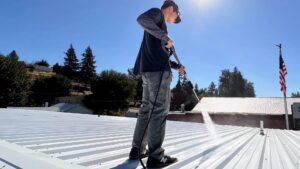Understanding Roof Coatings: What You Need to Know Before Applying
Roof coatings are an essential component in maintaining the longevity and efficiency of your roof. Whether you’re a homeowner looking to extend the life of your roof or a business owner aiming to improve energy efficiency, understanding roof coatings can help you make informed decisions. From their benefits to the application process, here’s everything you need to know.

What Are Roof Coatings?
Roof coatings are specialized formulations applied to roofing surfaces to enhance protection and performance. They are designed to seal cracks, provide a waterproof barrier, and reflect sunlight. Available in various types, including acrylic, silicone, and polyurethane, roof coatings cater to different needs and roof materials. Their versatility makes them suitable for flat, sloped, and metal roofs alike.
The Benefits of Roof Coatings
Roof coatings offer a wide range of benefits beyond basic protection. They help to reduce energy costs by reflecting solar radiation, keeping your building cooler during hot months. Additionally, they can prolong the lifespan of your roof by shielding it from harmful UV rays, extreme weather conditions, and general wear and tear. Roof coatings can also prevent leaks, reducing the risk of water damage to your property.
Key Factors to Consider Before Applying Roof Coatings
Before applying a roof coating, it’s crucial to evaluate the condition of your roof. Ensure there are no significant damages, such as cracks or structural weaknesses, as these may need to be repaired first. The type of roof material also influences the choice of coating, as some formulations work better with certain surfaces. For instance, silicone coatings are excellent for waterproofing, while acrylic coatings are more suited for climates with moderate weather.
Environmental conditions during the application process also play a significant role. Most coatings require dry and mild weather to cure properly. Humidity, rain, or extreme temperatures can affect the adhesion and effectiveness of the coating. Consulting with a professional roofing contractor can help you assess these variables and make the right decisions.
The Application Process
Applying a roof coating involves preparation, precision, and proper equipment. The surface must be thoroughly cleaned to remove dirt, debris, and old coatings. Pressure washing is often recommended for optimal results. Once the roof is clean and dry, the coating is applied using brushes, rollers, or spray equipment, depending on the roof type and the chosen product.
The drying and curing times vary, so it’s important to follow the manufacturer’s instructions. Some coatings may require multiple layers for maximum effectiveness, with sufficient time allowed between applications.
Common Myths About Roof Coatings
 There are misconceptions about roof coatings that may deter property owners from using them. One common myth is that coatings are only for old or damaged roofs. While they do restore aging roofs, they are equally beneficial for new roofs as a preventative measure.
There are misconceptions about roof coatings that may deter property owners from using them. One common myth is that coatings are only for old or damaged roofs. While they do restore aging roofs, they are equally beneficial for new roofs as a preventative measure.
Another misconception is that all roof coatings are the same. The truth is that the performance and longevity of a coating depend on its formulation, the roof type, and the application process. Investing in a high-quality product and ensuring proper application can make a significant difference.
When to Seek Professional Help
While roof coatings can be a DIY project, hiring a professional ensures proper application and long-lasting results. Professionals have the expertise to identify potential issues, recommend suitable products, and apply coatings efficiently. This can save you time and prevent costly mistakes.
